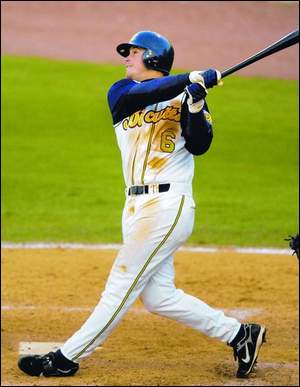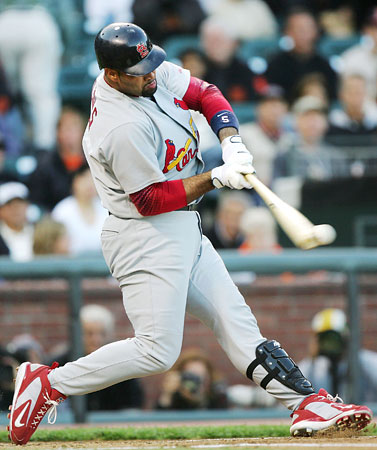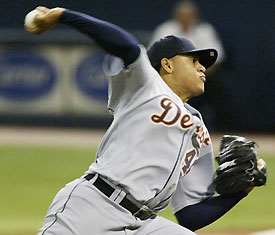
I wrote this article in December and posted it on Wax Heaven, but for those of you who haven't had a chance to read it, I've decided to post it here. There were are 2 follow-up posts to this one that I might post in another day or so.
I’ve had several people ask me to take a look at Joba, and I’ve been putting if off for a while simply because I haven’t quite figured out what I really think about him. At first glance it would seem that he’s everything a prospector could hope for. He’s young, he’s got a cool name, he plays for the Yankees, he throws gas and he pitches with his cap down low. Even though his BC auto prices seem high right now, there’s still room for growth, especially when you consider how much Yankees fans are willing to spend for their favorite players. So what’s holding me back? Why can’t I pull the ebay trigger? Well, part of my hesitancy has to do with this pesky list…
John Maine
Hideo Nomo
Kyle Davies
Steve Avery
Rick Ankiel
Kerry Wood
Mark Prior
Dontrelle Willis
Without digging too far back into baseball history, I came up with this list to illustrate the dangers of falling for the hype when it comes to young pitchers. Maine pitched 26 scoreless innings, Nomo transcended continents, Davies didn’t allow a run in his first 3 big league starts, Avery dissolved into thin air, Ankiel turned into an outfielder, Wood and Prior played for the Cubs, and Willis is taking his NL East 5.17 ERA over to the AL Central.
So I feel like I have plenty of reasons to be cautious with Joba, but most collectors are aware of the dozens of pitcher busts that started out so promising, and that still hasn’t deterred many people from driving Joba’s prices through the roof. To be fair, each player should be judged according to his individual situation and a list of duds hardly amounts to solid evidence against anyone. So in the spirit of accuracy, let’s look a closer at the facts and see what we can come up with (for the purpose of making clearer comparisons to other players, I will take the most definitive stats from a players minor league career and compare them by age rather than organization and level).
Joba Minor League Stats
Age IP ERA BB SO K/9 BB/9 WHIP
21 88.1 2.45 27 135 13.79 2.76 1.01
Those are good, solid stats, and looking at them it’s easy to see why Yankees fans are so excited about this guy. As a comparable, let’s use another fireball pitcher that saw similar success in the minors.
Roger Clemens Minor League Stats
Age IP ERA BB SO K/9 BB/9 WHIP
20 71.0 1.33 12 95 10.55 1.33 0.80
21 46.2 1.93 14 50 9.64 2.70 1.14
You could argue that Clemens was better in some areas while Chamberlain might have been better in others, but I don’t want to try extracting too much deep meaning from these numbers. It’s tough to compare two guys that played in the minors 20 years apart, but you can see that Chamberlain and Clemens both showed good control, high K/9 ratios, and strong ERA and WHIP totals at an early age, and that’s all I’m really interested in looking at right now. To get into more details, we’ll need some more recent comparison.
Scott Kazmir Minor League Stats
Age IP ERA BB SO K/9 BB/9 WHIP
20 101 2.49 42 104 9.26 3.74 1.20
Felix Hernandez Minor League Stats (strictly his AAA ball stats)
Age IP ERA BB SO K/9 BB/9 WHIP
19 88.0 2.25 48 100 10.23 4.91 1.25
Justin Verlander Minor League Stats
Age IP ERA BB SO K/9 BB/9 WHIP
22 118.2 1.29 26 136 10.35 1.98 0.89
Huston Street Minor League Stats
Age IP ERA BB SO K/9 BB/9 WHIP
20 25.3 1.42 8 30 10.67 1.42 1.15
Looking at these comparables, it’s not hard to understand why the Yankees faithful are so giddy. Put a guy like Huston Street or Verlander in New York and their card prices would probably be pretty high as well. Add in the fact that Chamberlain has a higher K/9 ratio and you’ve got one very appealing prospect. If his comparables are any indication, Joba could post a 3.50 ERA, maintain a nice K/9 ratio, improve on his BB/9 ratio, keep his WHIP around 1.25 and probably pick up some wins playing for the Yankees. And let’s not forget that as a perennial favorite to make the play-offs, the Yankees will provide plenty of opportunities for Chamberlain to make a name for himself in the postseason.
And now for a word of warning: Joba may be a starter in the Yankees rotation in ’08.
“But wait a minute,” you’re sayng, “wouldn’t it be better if he was a starter than if he continued to come out of the pen as a set-up man?” Well, yes and no. As a set-up man, Chamberlain had the advantage of facing a batter just once in a game, which usually meant that the batter had very few opportunities to adjust, which translated into higher strikeout numbers, a lower ERA, and an overall sense that Joba was unhittable. Take Huston Street for an example. Compared to Justin Verlander, Street has done considerably better in the majors even though they had similar minor league stats. As a starter, Verlander must face a team’s entire line-up 3 or 4 times in a game, and thus allows more opportunity for hitters to adjust and score runs on him. The same type of thing is likely to factor into Joba’s early career.
With all this in mind, am I sold on Joba? In short, yes. He’s as much the-real-deal as we’ve seen lately, and he’s in a great position to have a very successful early career in New York. Of course we have to be weary of injuries, burn out, bad luck, etc., but the Yankees seem to be making a concerted effort to bring their young pitchers along slowly and not work them too hard. Joba is also a big guy, so you have to like his chances of holding up under a long regular season and an intense post season schedule. Of course he’ll take some lumps along the way, so I expect his prices to drop back down a little bit at some point. If you’ve already spent some money on him, I would hold on to a few cards and hope for a big playoff run in ’08 by the Yanks while selling off a few at a profit while prices are high and optimism overrules reason. If you haven’t picked up any of his cards, I would suggest holding off until there’s a lull in prices and then buying a few cards and waiting for a nice post season or even a Cy Young type year.
Finally, I want to leave you with one last comparable, and then I’m done. I’ll let the numbers speak for themselves.
Josh Beckett Minor League Stats
Age IP ERA BB SO K/9 BB/9 WHIP
21 139.3 1.55 34 203 13.12 2.20 0.84









































